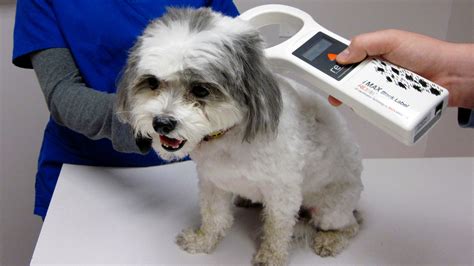Learn the benefits of microchipping your dog, how it’s done, finding a reputable service, updating information, and legal/ethical considerations. Understanding microchipping is crucial.
Understanding Microchipping for Dogs
Understanding microchipping for dogs is an important aspect of responsible pet ownership. This process involves the insertion of a tiny microchip under your dog’s skin, typically between the shoulder blades. This microchip contains a unique identification number that can be scanned by a special device. It is a permanent form of identification that can help reunite lost or stolen pets with their owners.
One of the key benefits of microchipping your dog is that it provides a secure and reliable way to ensure your pet can be identified if they ever become lost. Unlike traditional forms of identification such as collars and tags, which can easily fall off or be removed, a microchip is a permanent form of identification that cannot be lost or tampered with.
It is important for dog owners to educate themselves about the process of microchipping and the benefits it offers. With the growing number of pets that go missing each year, microchipping is a vital tool in ensuring the safety and security of our beloved pets.
Benefits of Microchipping Your Dog
Microchipping your dog can provide many benefits that can help keep your furry friend safe and secure. One of the key benefits of microchipping is that it can help reunite you with your pet if they ever get lost. With a microchip, your dog can be easily identified and returned to you, even if they lose their collar or tags. This can give you peace of mind knowing that your pet has a better chance of being found if they wander off.
Another benefit of microchipping your dog is that it is a permanent form of identification. Unlike collars and tags which can get lost or damaged, a microchip is implanted under your dog’s skin and will last for their entire life. This means that your pet will always have a way to be identified, no matter what happens to their physical identification.
Lastly, microchipping your dog can also be a legal requirement in some areas. In addition to the peace of mind it provides, microchipping your dog can also help you comply with local animal regulations and laws. By ensuring that your pet has a microchip, you can avoid any potential fines or penalties for not properly identifying your dog.
How Microchipping Is Done
Microchipping for dogs is a simple and quick procedure that is usually done by a veterinarian or a trained professional. The process involves using a syringe to inject a tiny microchip, about the size of a grain of rice, under the skin of the dog, usually between the shoulder blades. This is a relatively painless procedure, and most dogs do not even react to the insertion of the microchip.
Once the microchip is implanted, it remains in place for the lifetime of the dog. The microchip is made of a biocompatible material that does not cause any adverse reactions in the body. The process is similar to giving the dog a vaccine or a routine shot, and it can be done in just a matter of minutes.
After the microchip is implanted, the veterinarian will use a scanner to test the device and make sure it is functioning properly. The scanner emits a low-frequency radio wave that activates the microchip, allowing it to transmit a unique identification number to the scanner. This number is then registered to the dog’s information, including the owner’s contact details, in a national pet recovery database.
Finding a Reputable Microchipping Service
When it comes to finding a reputable microchipping service for your beloved dog, it’s important to do your research and choose a provider that is experienced and trustworthy. One of the best ways to find a reputable microchipping service is to ask for recommendations from your veterinarian or other pet owners. They can provide valuable insights and guidance on which service providers have a good reputation and provide high-quality microchipping services.
Additionally, you can also look for online reviews and testimonials from other pet owners who have used the microchipping service in question. Reading about their personal experiences can give you a better understanding of the quality of service and level of care provided by the microchipping provider.
Another important factor to consider when choosing a reputable microchipping service is to ensure that the provider is compliant with industry standards and regulations. This means that the service provider should use quality microchips and follow proper procedures for implanting the microchip in your dog. It’s also important to verify that the microchipping service is registered with a reputable pet recovery database to ensure that your dog’s information is accurately recorded and easily accessible in the event that your pet goes missing.
The Importance of Updating Microchip Information
One important aspect of microchipping your dog is ensuring that the information associated with the microchip is kept up to date. This means regularly updating your contact information, such as phone numbers and addresses, with the microchipping service or database.
Keeping this information current is crucial in ensuring that your dog can be reunited with you in the event that they become lost. If your contact information is outdated, it can significantly hinder efforts to locate and return your pet.
Additionally, updating your pet’s microchip information can also help in preventing unauthorized changes to the ownership status of your dog. By maintaining accurate and current information, you can protect your pet from being wrongfully rehomed or retained by someone else.
Common Misconceptions About Microchipping
One common misconception about microchipping is that it is a painful procedure for dogs. In reality, the microchipping process is quick and relatively painless. The microchip, which is about the size of a grain of rice, is inserted just beneath the skin between the shoulder blades. Most dogs experience little to no discomfort during the procedure, and any mild discomfort typically resolves quickly.
Another misconception is that microchips have GPS tracking capabilities. While microchips provide a permanent form of identification for dogs, they do not have the ability to track a dog’s location. Instead, microchips store a unique identification number that can be read by a scanner, allowing animal shelters, veterinary offices, and other facilities to identify a lost dog and reunite them with their owner.
Some people believe that a microchip can be used to store personal information, such as the dog owner’s address and phone number. However, microchips do not store any personal information. They simply provide a way to link a lost pet with their owner’s contact information, which is kept in a secure database maintained by the microchip company. In this way, a microchip helps ensure that a lost dog can be quickly identified and returned to their rightful home.
Legal and Ethical Considerations of Microchipping Dogs
When considering the legal and ethical aspects of microchipping your dog, it’s important to understand the regulations and guidelines set forth by your local government and animal welfare organizations.
Microchipping is a widely accepted practice, but it’s not without controversy. Some argue that it infringes on the rights of animals and could potentially be used for tracking or surveillance purposes. On the other hand, proponents of microchipping argue that it is a necessary tool for reuniting lost pets with their owners and ensuring their safety.
It’s crucial to stay informed about the laws and regulations surrounding microchipping in your area, as well as the ethical considerations of the practice. This includes understanding the potential implications for your pet’s privacy, safety, and overall well-being.
Frequently Asked Questions
What is microchipping for dogs?
Microchipping is a procedure where a small chip is implanted under a dog’s skin, typically between the shoulder blades. This chip contains a unique identification number that can be scanned by a vet or animal shelter.
Is microchipping painful for dogs?
The procedure is quick and relatively painless for dogs. It is similar to a routine vaccination and does not require anesthesia.
What are the benefits of microchipping my dog?
Microchipping can help reunite lost dogs with their owners, as the unique identification number can be used to contact the owner. It is a permanent form of identification that cannot be lost or removed.
How much does it cost to microchip a dog?
The cost of microchipping a dog can vary, but it is generally an affordable one-time expense. Some animal shelters or veterinary clinics may even offer discounted or low-cost microchipping services.
Is microchipping mandatory for dogs?
Microchipping may be mandatory in some areas, so it is important to check the local laws and regulations. Even if it is not required by law, microchipping is highly recommended for all pet dogs.
Can any vet perform a microchipping procedure?
Most veterinarians are trained and equipped to perform microchipping procedures. It is important to have the microchip inserted by a qualified and experienced professional to ensure it is done correctly.
Can a microchip track my dog’s location?
A microchip does not have GPS tracking capabilities, so it cannot track your dog’s location. It is simply a form of identification that can be scanned by a vet or animal shelter to access your contact information.





